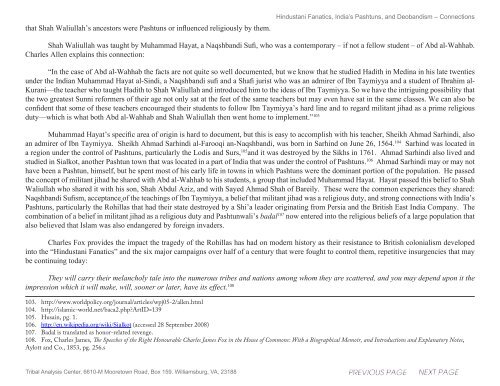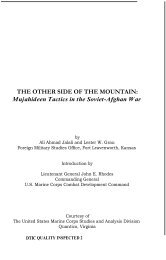Hindustani Fanatics, India’s Pashtuns, <strong>and</strong> Deob<strong>and</strong>ism – ConnectionsAllen explains the more pragmatic approach taken by the other group, led by Muhammad Qasim <strong>and</strong> Rashid Ahmad:“Their leaders were Muhammad Qasim <strong>and</strong> Rashid Ahmad, two of the four-man group of jihadis that had left Delhi in the summer of 1857 tocreate their own Dar ul-Islam at Thana Bhawan. Muhamm<strong>and</strong> Qasim had acted as the group’s military comm<strong>and</strong>er <strong>and</strong> may well have had a h<strong>and</strong> inthe massacre at Shamlee mosque; Rashid Ahmad had presided over the imposition of sharia as the group’s judge.“In May 1866, one year after the ending of the Patna trial, these two mullahs set up their own madrassa at Deob<strong>and</strong>, a small town seventy-fivemiles north of Delhi <strong>and</strong> within a day’s march of their earlier stamping-ground at Thana Bhawan.” 98Firm evidence connecting Muhammad Qasim <strong>and</strong> Rashid Ahmad to the Rohilla Pashtuns is not available in the literature surveyed to thispaper, but sufficient circumstantial evidence can be found to support this assertion. For instance, Thana Bhawan, located north of Delhi is insideIndia’s current Uttar Pradesh state, the Rohilla homel<strong>and</strong> destroyed by Shuja ud-Daulah <strong>and</strong> Warren Hasting’s East India Company forces in 1774.Iqbal Husain explains that this region was populated by large numbers of “Afghans” that we now know were Rohillas, or probably Yusufzai Pashtuns.Muhammad Qasim Nanautawi’s surname was derived from his village of origin, Nanauta, which is located in Uttar Pradesh’s Saharanpurdistrict. According to Iqbal Husain, Nanauta was under Afghan control <strong>and</strong> they lost some of the l<strong>and</strong> they had owned by 1844. 99Rashid Ahmad Gangohi’s surname was also derived from his village of origin, Gangoh, another of Uttar Pradesh’s Afghan villages that wasalso located in Shahranpur district. 100Finally, not only was Deob<strong>and</strong> within a “day’s march” of Thana Bhawan, Gangoh <strong>and</strong> Nanauta were even closer. Deob<strong>and</strong> is also locatedin what was once Rohilkh<strong>and</strong>, populated <strong>and</strong> once dominated by Yusufzai Pashtuns. It appears probable that the Deob<strong>and</strong>i Madrassa was probablycreated by a pair of Yusufzai Pashtuns, probably taught in Pashto, as well as Arabic, <strong>and</strong> the missionaries created at Deob<strong>and</strong> were quickly acceptedby the Pashtuns on the Afghan frontier, especially in the northern sections where they called themselves “Pakhtuns” in a Pashto dialect that wasessentially unintelligible in the Pashtun south <strong>and</strong> where Qadiriya Sufism’s influence remained strong. The difference was simple: the early graduatesof Deob<strong>and</strong>’s new madrassa, probably Rohilla Yusufzais in many cases, were unable to communicate with the southern Pashtuns <strong>and</strong> their effortswere concentrated in the Pashtun belt’s northern areas where the missionaries shared a common language with those tribes they sought to influence<strong>and</strong> covert to the new form of Islam.The connection to India’s Pashtuns appears to have occurred well before Sayed Ahmad Shah led his followers to the region adjoiningPeshawar. Shah Waliullah, the mentor of many of India’s future religious revolutionaries, was from the town of Phulat in what is now Muzaffarnagardistrict of Uttar Predesh – the center of the Rohilla Pashtuns. One of his ancestors migrated to India <strong>and</strong> settled in the town of Rohtak 101 , a locationconnected to the Pashtuns by the word “Roh” in its name – Rohilla. While Rohtak 102 is located in a strategic location west of Delhi, it is very possible98. Ibid, pg. 206.99. Husain, pg. 7.100. From Wikipedia: Gangoh is a city <strong>and</strong> a municipal board in Saharanpur district in the state of Uttar Pradesh, India.101. From Wikipedia: The forefather of Shah Waliullah, Shaikh Shamsuddin Mufti came to the subcontinent <strong>and</strong> settled in Rothak during the initial period of Islamic rule.102. Lying close to the imperial city of Delhi, the tract which now comprises the Rohtak district,was often granted in military Jagir by the Sultan <strong>and</strong> Mughal emperors tothe Nobles of the court. For this reason Rajput, Brahman, Afghan, <strong>and</strong> Baluch chiefs have at different times enjoyed its revenues. http://rohtak.nic.in/ginf1.htm (accessed 25September 2008)Tribal Analysis Center, 6610-M Mooretown Road, Box 159. Williamsburg, VA, 23188
that Shah Waliullah’s ancestors were Pashtuns or influenced religiously by them.Hindustani Fanatics, India’s Pashtuns, <strong>and</strong> Deob<strong>and</strong>ism – ConnectionsShah Waliullah was taught by Muhammad Hayat, a Naqshb<strong>and</strong>i Sufi, who was a contemporary – if not a fellow student – of Abd al-Wahhab.Charles Allen explains this connection:“In the case of Abd al-Wahhab the facts are not quite so well documented, but we know that he studied Hadith in Medina in his late twentiesunder the Indian Muhammad Hayat al-Sindi, a Naqshb<strong>and</strong>i sufi <strong>and</strong> a Shafi jurist who was an admirer of Ibn Taymiyya <strong>and</strong> a student of Ibrahim al-Kurani—the teacher who taught Hadith to Shah Waliullah <strong>and</strong> introduced him to the ideas of Ibn Taymiyya. So we have the intriguing possibility thatthe two greatest Sunni reformers of their age not only sat at the feet of the same teachers but may even have sat in the same classes. We can also beconfident that some of these teachers encouraged their students to follow Ibn Taymiyya’s hard line <strong>and</strong> to regard militant jihad as a prime religiousduty—which is what both Abd al-Wahhab <strong>and</strong> Shah Waliullah then went home to implement.” 103Muhammad Hayat’s specific area of origin is hard to document, but this is easy to accomplish with his teacher, Sheikh Ahmad Sarhindi, alsoan admirer of Ibn Taymiyya. Sheikh Ahmad Sarhindi al-Farooqi an-Naqshb<strong>and</strong>i, was born in Sarhind on June 26, 1564. 104 Sarhind was located ina region under the control of Pashtuns, particularly the Lodis <strong>and</strong> Surs, 105 <strong>and</strong> it was destroyed by the Sikhs in 1761. Ahmad Sarhindi also lived <strong>and</strong>studied in Sialkot, another Pashtun town that was located in a part of India that was under the control of Pashtuns. 106 Ahmad Sarhindi may or may nothave been a Pashtun, himself, but he spent most of his early life in towns in which Pashtuns were the dominant portion of the population. He passedthe concept of militant jihad he shared with Abd al-Wahhab to his students, a group that included Muhammad Hayat. Hayat passed this belief to ShahWaliullah who shared it with his son, Shah Abdul Aziz, <strong>and</strong> with Sayed Ahmad Shah of Bareily. These were the common experiences they shared:Naqshb<strong>and</strong>i Sufism, acceptance of the teachings of Ibn Taymiyya, a belief that militant jihad was a religious duty, <strong>and</strong> strong <strong>connections</strong> with India’sPashtuns, particularly the Rohillas that had their state destroyed by a Shi’a leader originating from Persia <strong>and</strong> the British East India Company. Thecombination of a belief in militant jihad as a religious duty <strong>and</strong> Pashtunwali’s badal 107 now entered into the religious beliefs of a large population thatalso believed that Islam was also endangered by foreign invaders.Charles Fox provides the impact the tragedy of the Rohillas has had on modern history as their resistance to British colonialism developedinto the “Hindustani Fanatics” <strong>and</strong> the six major campaigns over half of a century that were fought to control them, repetitive insurgencies that maybe continuing today:They will carry their melancholy tale into the numerous tribes <strong>and</strong> nations among whom they are scattered, <strong>and</strong> you may depend upon it theimpression which it will make, will, sooner or later, have its effect. 108103. http://www.worldpolicy.org/journal/articles/wpj05-2/allen.html104. http://islamic-world.net/baca2.php?ArtID=139105. Husain, pg. 1.106. http://en.wikipedia.org/wiki/Sialkot (accessed 28 September 2008)107. Badal is translated as honor-related revenge.108. Fox, Charles James, The Speeches of the Right Honourable Charles James Fox in the House of Commons: With a Biographical Memoir, <strong>and</strong> Introductions <strong>and</strong> Explanatory Notes,Aylott <strong>and</strong> Co., 1853, pg. 256.sTribal Analysis Center, 6610-M Mooretown Road, Box 159. Williamsburg, VA, 23188
- Page 7 and 8: Hindustani Fanatics, India’s Pash
- Page 9 and 10: Hindustani Fanatics, India’s Pash
- Page 11 and 12: Hindustani Fanatics, India’s Pash
- Page 13 and 14: Hindustani Fanatics, India’s Pash
- Page 15 and 16: And Charles Allen described the sce
- Page 17 and 18: Hindustani Fanatics, India’s Pash
- Page 19 and 20: Charles Allen provided additional d
- Page 21 and 22: Hindustani Fanatics, India’s Pash
- Page 23 and 24: Hindustani Fanatics, India’s Pash
- Page 25 and 26: Hindustani Fanatics, India’s Pash
- Page 27: Hindustani Fanatics, India’s Pash
- Page 32: Hindustani Fanatics, India’s Pash
- Page 35 and 36: Hindustani Fanatics, India’s Pash
- Page 37 and 38: Hindustani Fanatics, India’s Pash
- Page 39: Hindustani Fanatics, India’s Pash
- Page 42 and 43: Hindustani Fanatics, India’s Pash
- Page 44 and 45: Hindustani Fanatics, India’s Pash
- Page 46 and 47: Hindustani Fanatics, India’s Pash
- Page 48 and 49: Hindustani Fanatics, India’s Pash
- Page 50 and 51: Hindustani Fanatics, India’s Pash
- Page 52 and 53: Hindustani Fanatics, India’s Pash
- Page 54 and 55: Hindustani Fanatics, India’s Pash
















